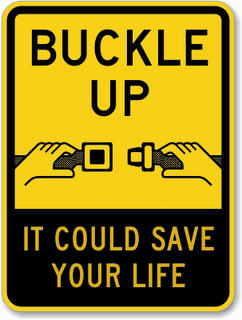 Motor vehicle crashes are the leading cause of death for U.S. teens. Fortunately, teen motor vehicle crashes are preventable, and proven strategies can improve the safety of young drivers on the road. As parents, it’s our job to educate our children on the importance of seatbelt use. Please see the staggering statistics below and talk to your children about wearing their seatbelts-it could save their life.
Motor vehicle crashes are the leading cause of death for U.S. teens. Fortunately, teen motor vehicle crashes are preventable, and proven strategies can improve the safety of young drivers on the road. As parents, it’s our job to educate our children on the importance of seatbelt use. Please see the staggering statistics below and talk to your children about wearing their seatbelts-it could save their life.
How big is the problem?
In 2013, 2,163 teens in the United States ages 16–19 were killed and 243,243 were treated in emergency departments for injuries suffered in motor vehicle crashes. That means that six teens ages 16–19 died every day from motor vehicle injuries.
Young people ages 15-24 represent only 14% of the U.S. population. However, they account for 30% ($19 billion) of the total costs of motor vehicle injuries among males and 28% ($7 billion) of the total costs of motor vehicle injuries among females.
Who is most at risk?
The risk of motor vehicle crashes is higher among 16-19-year-olds than among any other age group. In fact, per mile driven, teen drivers ages 16 to 19 are nearly three times more likely than drivers aged 20 and older to be in a fatal crash.
Among teen drivers, those at especially high risk for motor vehicle crashes are:
- Males: In 2013, the motor vehicle death rate for male drivers and passengers ages 16 to 19 was almost two times that of their female counterparts.
- Teens driving with teen passengers: The presence of teen passengers increases the crash risk of unsupervised teen drivers. This risk increases with the number of teen passengers.
- Newly licensed teens: Crash risk is particularly high during the first months of licensure.
What factors put teen drivers at risk?
- Teens are more likely than older drivers to underestimate dangerous situations or not be able to recognize hazardous situations.
- Teens are more likely than older drivers to speed and allow shorter headways (the distance from the front of one vehicle to the front of the next). The presence of male teenage passengers increases the likelihood of this risky driving behavior.
- Among male drivers between 15 and 20 years of age who were involved in fatal crashes in 2012, 35% were speeding at the time of the crash and 25% had been drinking.
- Compared with other age groups, teens have the lowest rate of seat belt use. In 2013, only 55% of high school students reported they always wear seat belts when riding with someone else.
- At all levels of blood alcohol concentration (BAC), the risk of involvement in a motor vehicle crash is greater for teens than for older drivers.
- In 2013, 17% of drivers aged 16 to 20 involved in fatal motor vehicle crashes had a BAC of .08% or higher.
- In a national survey conducted in 2013, 22% of teens reported that, within the previous month, they had ridden with a driver who had been drinking alcohol. Among students who drove, 10% reported having driven after drinking alcohol within the same one-month period.
- In 2012, 71% of drivers aged 15 to 20 were killed in motor vehicle crashes after drinking and driving were not wearing a seat belt.
- In 2013, 51% of teen deaths from motor vehicle crashes occurred between 3 p.m. and midnight and 54% occurred on Friday, Saturday, or Sunday.
How can deaths and injuries resulting from crashes involving teen drivers be prevented?
There are proven methods to helping teens become safer drivers.
Seat Belts
Of the teens (aged 13-20) who died in passenger vehicle crashes in 2013 approximately 56% were not wearing a seat belt at the time of the crash. Research shows that seat belts reduce serious crash-related injuries and deaths by about half.
Not Drinking & Driving
Enforcing minimum legal drinking age laws and zero blood-alcohol tolerance laws for drivers under age 21 are recommended.
Graduated Driver Licensing Programs (GDL)
Driving is a complex skill, one that must be practiced to be learned well. Teenagers’ lack of driving experience, together with risk-taking behavior, puts them at heightened risk for crashes. The need for skill-building and driving supervision for new drivers is the basis for graduated driver licensing programs, which exist in all US states and Washington, DC. GDL provides longer practice periods, limits driving under high risk conditions for newly licensed drivers, and requires greater participation of parents in their teens’ learning-to-drive. Research suggests that the more comprehensive GDL programs are associated with reductions of 38% and 40% in fatal and injury crashes, respectively, among 16-year-old drivers. When parents know their state’s GDL laws, they can help enforce the laws and, in effect, help keep their teen drivers safe.
Make sure your young driver is aware of the leading causes of teen crashes:
- Driver inexperience
- Driving with teen passengers
- Nighttime driving
- Not using seat belts
- Distracted driving
- Drowsy driving
- Reckless driving
- Impaired driving
If you have any questions or need tips on how to implement seatbelt use in your family, feel free to give us a call at (701) 402-6644.
Source: https://www.cdc.gov/
